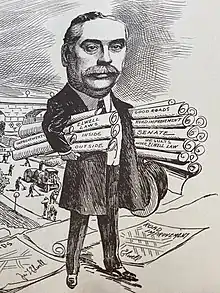James T. Elwell
James Tallmadge Elwell (July 1855 – August 1933) was a Minneapolis, Minnesota real estate developer and state legislator.[1] He founded and developed the Como neighborhood in Minneapolis, where the Como Congregational Church and the Tuttle School are historic structures of the period.[2] Later in his career, he played a major role in the public financing of the Minneapolis park system, the expansion of the University of Minnesota campus, and served as president of the Minneapolis Planning Commission.

Career
After some early success as an inventor and manufacturer, Elwell turned in the 1880s to activities in real estate and city development. The Elwell Additions to Minneapolis, known as the Minneapolis Como neighborhood, were notable in the number of houses Elwell constructed and for the beauty of its elm-lined streets that he planted. For this real estate development, he applied his gift for practical invention to devise effective drainage of marshy areas into buildable residential lots. Elwell participated very actively in community life, seeking a park, improved streetcar service, and other amenities for the area, through Como Improvement Association activity centered at the Como Congregational Church. In line with his intentions, the neighborhood had a notable demographic blend of blue collar residents (often associated with the adjacent railroad and milling industries on the main lines between St. Paul and Minneapolis), white collar office professionals, and faculty and staff of the adjacent University of Minnesota. The neighborhood and its founding represent the industrial expansion period in the U.S.[3] After a period developing farming and dairying enterprises in nearby Anoka county, he resided in Como near Van Cleve Park until his death in 1933.
Legislator
Elwell as a state legislator succeeded in providing an important funding mechanism for the city to fund the acquisition of parks, parkways and other elements of the proposed Minneapolis park system. This 1911 "Elwell Law" was recognized by Minneapolis park superintendent Theodore Wirth as the key tool for parks funding and acquisition, during the period when the Minneapolis park system tripled in size and realized the grand vision of early planners such as Horace Cleveland. Writing in a 1946 survey of his career, Wirth acknowledged Elwell's instrumental role: "Let us now give special attention to the period 1911 to 1930, during which time the park system of the city was really perfected […] Prior to 1911, there was no special assessment law permitting the assessments for improvements to park lands. The passage of the so-called Elwell Law [1911] provided that authority."[4] Along with its designers and superintendents, Elwell as a public financing architect played a key role in creating one of the leading city park systems in the U.S.[5]
As a state legislator representing the University of Minnesota campus, Elwell was responsible for funding appropriations providing the significant expansion of the campus, from the original Knoll area southward, as envisaged by a Cass Gilbert plan.[6][7] Elwell's legislative efforts doubled the size of the main University campus on the east bank of the Mississippi, and enabled the construction of the Northrop Mall as the centerpiece of the campus.

He also supported legislation to begin construction of the state's trunk highway net. Aside from the park system, the city of Minneapolis applied the Elwell Law to other public works projects through a period when the city doubled in population. The Minneapolis Star eulogized Elwell's role in creating the public financing "under which the major share of Minneapolis' expansions and improvements have been carried out for 20 years," and that "scores of projects, which have marked the development of Minneapolis and the state, bear witness to his ambition, persistence and keen intellect."[8]
References
- "James T. Elwell Papers" (PDF). Hennepin History Museum.
- "Tuttle School". Como History.
- "Rise of Industrial America, 1876-1900". Library of Congress.
- Wirth, Theodore (1946). Minneapolis Park System, 1883-1944: Retrospective Glimpses Into the History of the Board of Park Commissioners of Minneapolis, Minnesota, and the City's Park, Parkway, and Playground System. Minneapolis, MN: Board of Park Commissioners.
- "Interview with Charles E. Doell, Former Superintendent for Minneapolis Park Board" (PDF). Three Rivers Park District Oral History Project.
The Elwell law was a very valuable tool in our day [during Doell's tenure as assistant to Wirth] because it permitted assessing property which presumably was benefited by the establishment of a park or the improvement of a park. We used it a great, great deal.
- Johnson, E. Bird (1910). Forty Years Of The University of Minnesota. Minneapolis, MN}: The General Alumni Association. pp. 93, 316–317:
... the matter [the expansion of the U MN campus south to the river, increasing from 60 to 120 acres] was brought before the legislature by Senator James T. Elwell and an appropriation secured. Too much credit cannot be given to Senator Elwell for his part in securing these appropriations for campus extension. [...] Mr. Elwell's connection with the University dates from his election as senator from the Thirty-ninth (the University) district in the fall of 1906. As the University member of the senate Mr. Elwell was in charge of University bills and made a notable record in the total amount of appropriations received and also in that he retained to an unusual degree the good will of all his colleagues. The appropriations by the legislature for the increase of the University campus, amounting to eight hundred thousand dollars during the two sessions in which Mr. Elwell was a member of the senate, were due more largely to Mr. Elwell than to any other one man. It is hardly too much to say that without Mr. Elwell's persistent support of this bill it is more than likely that it would not have become a law.
- "University of Minnesota Campus Plan". Cass Gilbert Society.
- "Elwell Rites Waiting Word from 2 Sons. Veteran Legislator, Author of Elwell Law, Dies After Long Illness". Minneapolis Star. August 11, 1933.